Great landscaping around a swimming pool can really make your pool pop. That said, plants and trees need to be chosen carefully. Trees with lots of leaf litter, excessive pollen, berries, or budding debris can cause a lot of extra work for you and your pool filter.
Furthermore, trees with extensive root systems can damage pool walls or pool plumbing. And cute little trees that grow into huge monsters can block the sun’s warmth, or may even block the sight and sounds of the pool, which can be unsafe.
Many pool guys will say “the best trees for a pool are no trees at all.” But this is not always realistic, nor is it desirable in most cases. So what are the best trees to plant around a pool? Which trees are the worst for pool maintenance? Let’s take a look and find out!
Best Trees to Plant Around a Pool
First, consider those things which may limit your pool tree selection.
Landscaping Considerations
Climate: Pools located in more temperate hardiness zones (southern states) have a wider variety of trees that can flourish around the pool. Northern pools can still use many tropicals if planted in large pots, or cut back during fall and mulched over.
Shade: If you are specifically looking for shade around the pool or in a certain area of your yard, that can help guide your tree choice. Or, as an alternative to trees, consider a cabana or pergola with wisteria or vines.
Privacy: Are you trying to block out the neighbors’ prying eyes, extra noise, or a less than perfect view? Fast growing evergreens may be a good choice for one or two sides of the pool.
Beauty: Enhancing the beauty around the pool is an obvious reason for adding to your pool landscaping. Flowering trees, fruit trees, and deciduous trees (those that shed leaves during fall) may be pretty, but can be quite messy.
Excellent Tree Choices
The best trees to plant around a pool include: acacia, banana, citrus, evergreens (arbor vitae, cypress, spruce), holly and magnolia (also evergreen), olive trees (non fruit bearing), oleander* (actually a large bush), and windmill palms (hardy in the southern states, all the way up to zone 6).
*IMPORTANT! Though popular as an ornamental landscaping bush, homeowners with pets or young children should avoid planting oleander. This is because oleander plants produce high levels of toxins. As little as a single leaf can kill if ingested.
Other “Good Seeds”
Daylilies and Sedums: Visually pleasing, but still low maintenance.
Ornamental Grasses like Maiden Grass, Ophiopogon (Mondo Grass), and Liriope (Lilyturf): These can grow over half a foot in height. They can be used around an inground pool or near the base of an above ground pool.
Calycanthus, a.k.a. Sweet Shrubs: These can add pleasant aromas to the yard, much like citrus trees and oleander can.
Harbour Dwarf Nandina and Dwarf Yaupon Holly: Both are great small shrubs to line the border of a walking path or the perimeter of the pool decking. They’re low maintenance and very resilient.
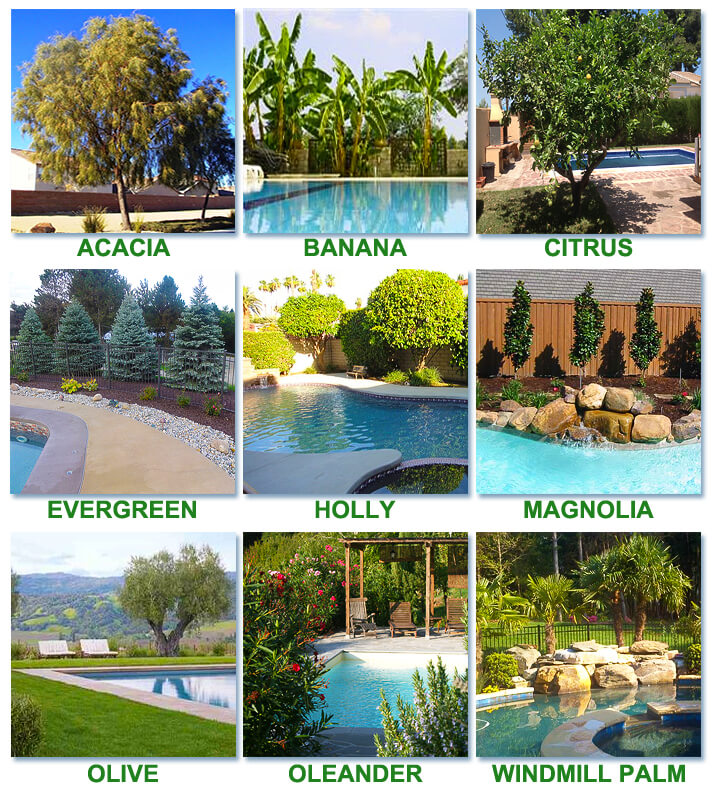
Worst Trees to Plant Around a Pool
Just as there are trees that do well around pools, there are lots of trees that won’t. In most cases, chlorinated water or salt pool splash-out is not much of a concern, as long as trees around a pool are regularly watered.
Landscaping Considerations
Climate: Again the regional climate is the number one consideration when choosing your trees. Refer to the map above and look for trees that are “hardy” in your local zones. A tree that does well in zone 8 may not survive winters in zone 7.
Litter: Some trees constantly shed buds, flowers, leaves, and bark. With a little wind, this can quickly fill your pool with debris. Using a leaf catcher or even a solar cover can mitigate some of this issue. Deciduous trees are not necessarily bad, but will give the backyard a bare appearance during winter.
Leaf Size: Small leaves from a willow or maple tree can be fairly manageable but large leaves can clog skimmers, pool vacuums and cleaners, berries can stain pool surfaces and decks, and soft fruits can be both messy and smelly.
Root Systems: Most trees grow root systems of about the same size as the tree branch systems. Some trees have very aggressive roots that can damage pool walls or vinyl liners when planted too close to inground pools. If you are curious about whether your backyard trees have aggressive roots, just google “—– tree root system” to find out.
Poor Tree Choices
The worst trees to plant around a pool include (among others):
Mulberries, Cottonwoods, Aspens, Willows, Silver Maple, and American Elm Trees: These trees have extensive and invasive root systems that will seek moisture at any cost. If close enough, these trees can erode the ground around your swimming pool, and will seek and destroy underground plumbing.
Palm Trees, Fruit Trees, Grape Vines, Berry Plants, Nut Trees, and Flowering Trees: Any tree or plant that falls within this category will lead to excessive cleaning and possible staining. Insects and rodents will also be attracted to these choices.
Needle Bearing Evergreen Trees, Large Deciduous Trees, and Crape Myrtles: Larger leaves that end up in the swimming pool can complicate vacuuming and will put extra stress on the pool equipment. Finer needles that drop are known to sneak by the skimmer baskets and clog up your pool pump impeller.
Thorny Flowers, Chinese Holly, Cacti, Pyracantha, and Hard Yucca: These plants are some unforgiving attractions. Most pool users will want to avoid brushing up against any of those mentioned without a shirt protecting your back. As long as they’re kept away from frequent pathways around the pool, you may still be able to use these to accent your backyard landscape.
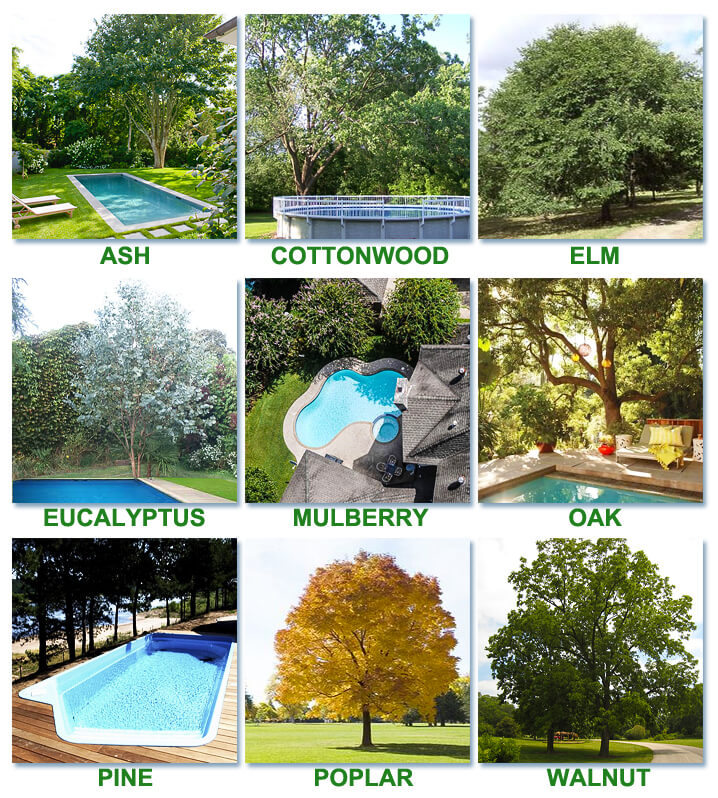 Landscaping Control Tips for Pool Owners
Landscaping Control Tips for Pool Owners

Let me finish by saying this – I love trees. If they were there before the pool, that doesn’t necessarily mean that you have to remove them once the pool is installed. Regular maintenance and trimming will help keep any potential issues in check. And, as we mentioned earlier, a leaf catcher net or solar cover can do wonders for managing debris loads. Make sure to invest in a good leaf rake, and consider purchasing a leaf canister for your vacuum or suction side pool cleaner to keep heavy leaf debris from clogging up the skimmer and pump baskets. For extremely leafy pools, a pressure side or robotic cleaner may be the best choice for an automatic pool cleaner. You can also use something like a leaf gulper for quick debris cleanup.
Most tree roots spread out as far as their branches, but some types of thirsty trees will extend well beyond that. I swear that some trees can “smell” the water in the pool, and make a beeline for it, stretching their roots out until they poke a hole in the liner or bust up the floor and walls of your pool. Do yourself a favor, here. Find some nice small plants or bushes to put around your pool and leave the trees to the other parts of your yard.
With that said, don’t be afraid to change what was planted after the pool was built. If you have trees around a pool that have become undesirable tenants, you can always start over with something new!

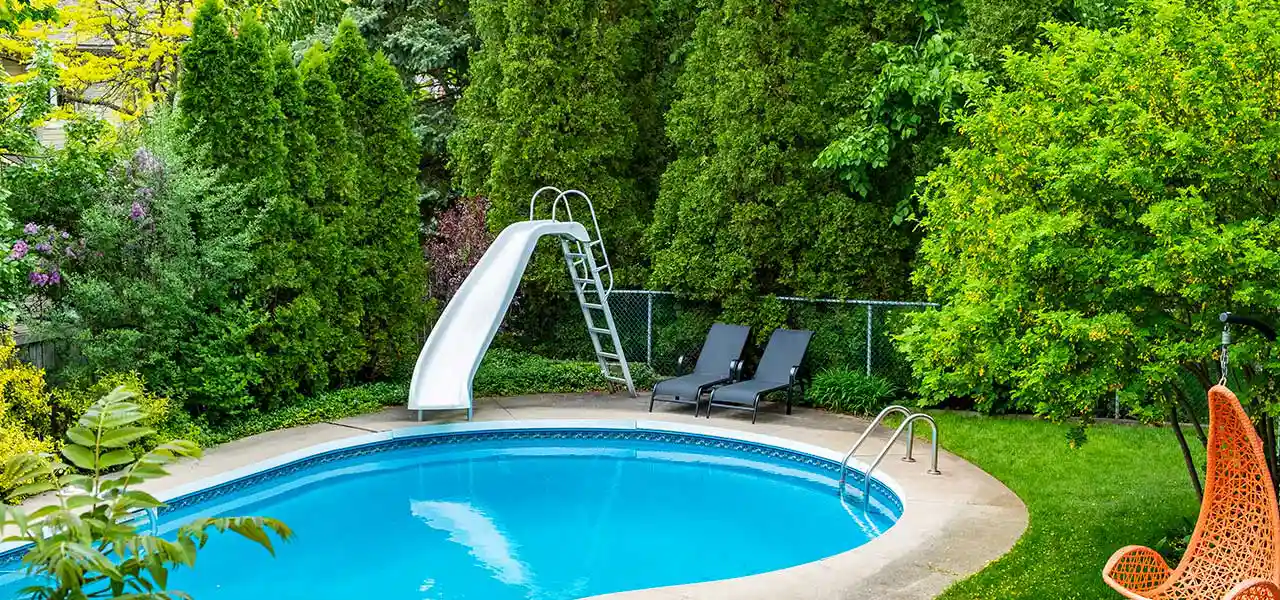
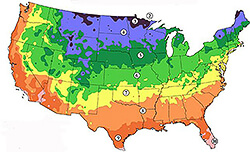
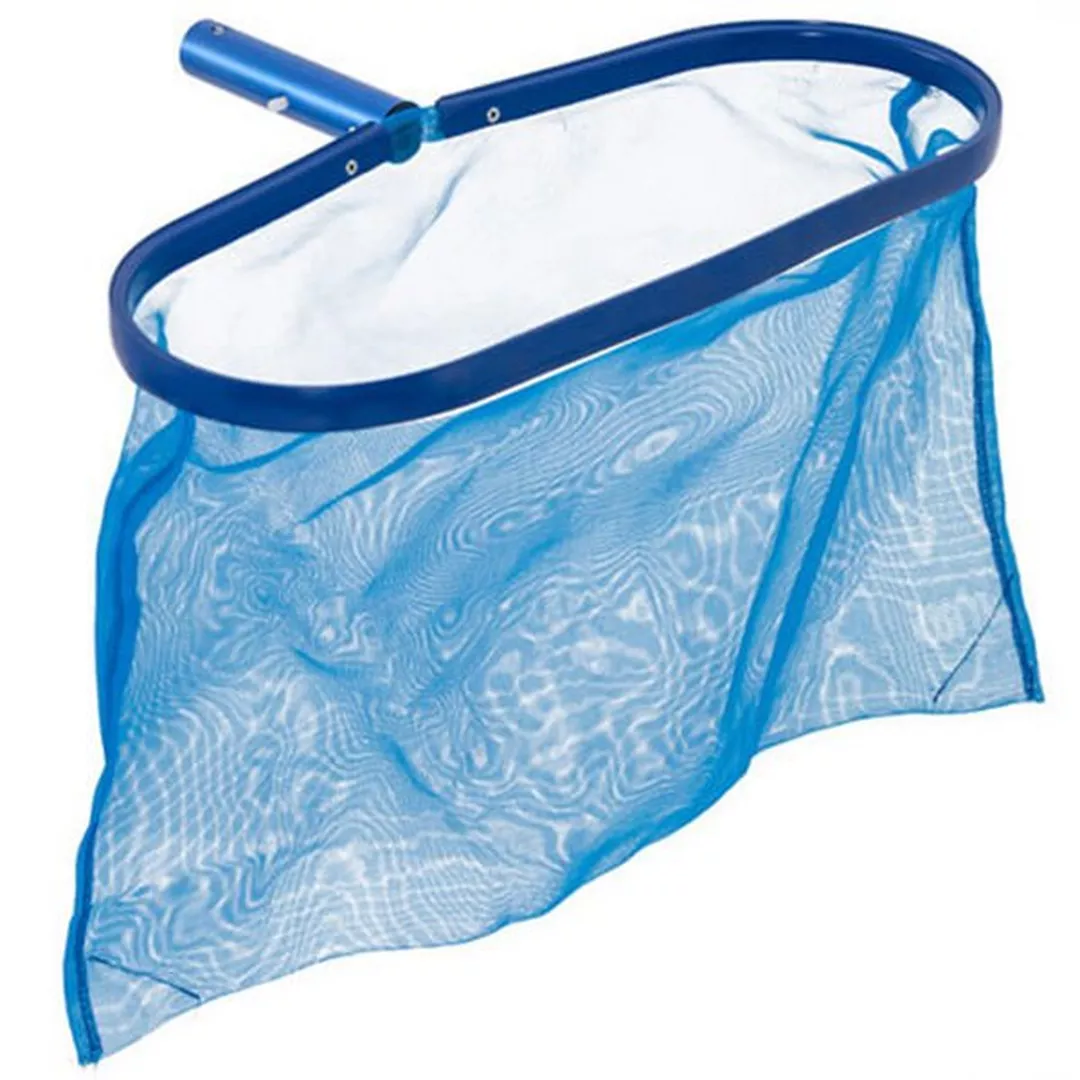

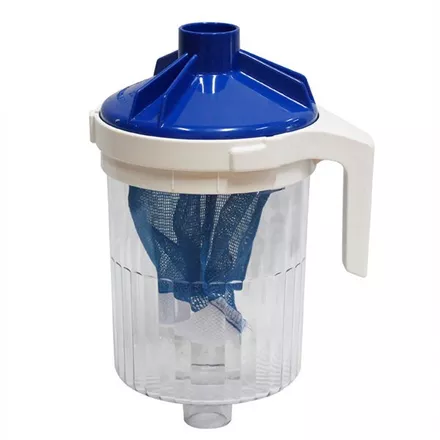
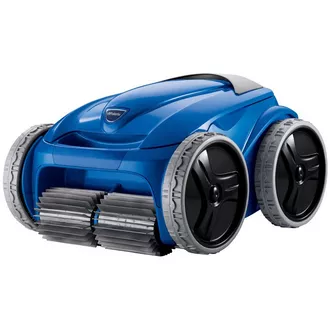

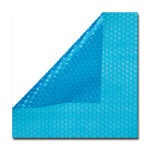
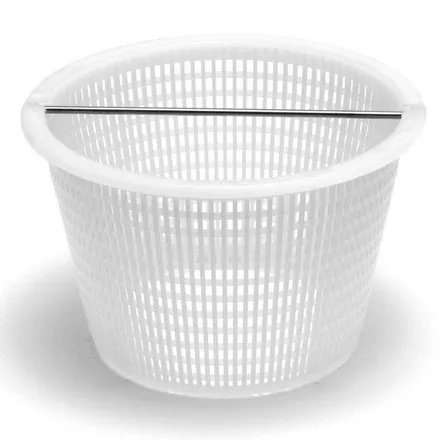
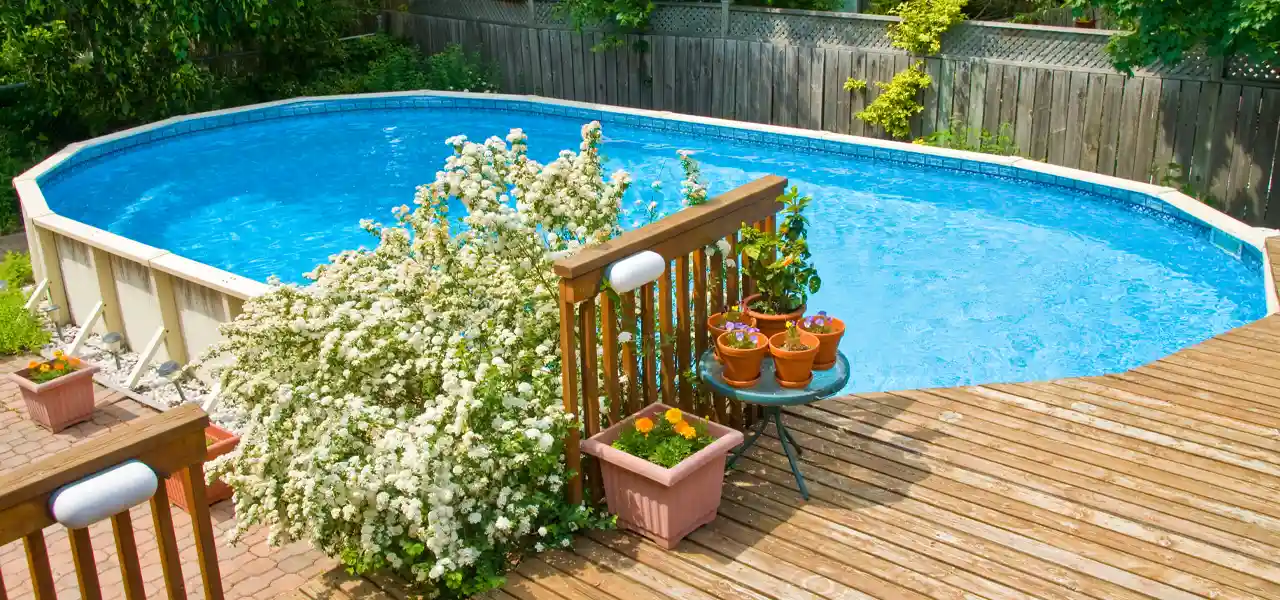
We are putting a fiberglass pool in right now and I was possibly going to put an ornamental Japanese maple tree in at least 15 feet or so away from the pool. We also will have an automatic cover on the pool. I don’t care about shade just the looks of the tree plus I’ve been wanting one of these trees. Any thoughts on doing this would be helpful?
Hi Marna, Japanese Maple, and most maple trees should be safe around a pool, as the root systems are not known to be aggressive or overly expansive. 15 feet is a good distance anyway ~ enjoy! I love those trees!
I was wondering your thoughts on Areca palms all around a pool in south Florida for privacy? There is not much space between the poon and fence. I want to make sure that the routes don’t affect the pool at all. What do you think?
Hi, Areca Palm, Golden Cane Palm and Butterfly Palm (all the same) tend to have a shallow and thin root system, that would not normally pose any danger to pool walls or pipes. Here is a nice article on the Areca Palm, for more information on care and such… https://www.junglemusic.net/The_Areca_Palm/The_Areca_Palm.html
Hi Dave-I need “height” added to my landscape. I have two feet between my pool deck and the block wall. Behind the block wall is a rip rap. I planted some shrubs that grow 4 ft max. What tree would grow in small space that could give me 5-15ft of height and privacy? Any thoughts about vines? I live in Tucson AZ.
Hi Luna, how about a maple or a evergreen spruce? Crepe myrtle if you have good sun, or Citrus if you are in the right area. Ivy would make a nice backdrop, if you are allowed to erect a quite tall rack of some strength, above the existing fence, or behind it, you could grow a very nice batch of honeysuckle, wisteria or clematis, or just green ivy – after a few years could look really nice – I’m picturing a 3-4′ high horizontal row of greenery, above the existing fence, and covering the top of the fence, thus creating a very high fence but with a soft top edge…?
I was thinking about planting Thuja Green Gianta a new evergreen that was bred for privacy. Which why I am considering it.
It would be close to my in ground pool 10′ to 15′ away. It is supposed to be a fast growing tree. Do you recommend?
Hi Carlos, I like Thujas, but they can get really big! 60 ft or so, and may have, under ideal conditions, a root spread equal to that amount. However, Thuja roots are not especially aggressive, though 10′ away is not that far. You could consider a root barrier, using geotextile fabrics, or barrier walls, between the pool and the tree, along with plenty of room to spread in the other directions, and you’d be ok. Most trees will not damage a pool wall – as long as they have somewhere else to go – and also remember, if you prune a tree as it grows, and keep it from becoming a 60 ft tree, that will reduce root growth. A 60′ tree may need nearly 60′ in roots, but a 15′ tree, may only need 15′ of root space. Generally speaking, although over-pruning can hurt some trees, but not Thuja, I don’t think…
Crepe myrtles grow fast and provide good shade – but aren’t they constantly dropping leaves and flowers? Are they still a good choice near a pool? And they do not have deep root systems that would damage the pool? I have 4 feet between my driveway and pool but need a tree here to provide shade over the pool from southern sun.
Hi, Crepe Myrtles, and most flowering trees actually, have a brief period when things can get messy yes. But in my experience, they are fairly small trees, and the blossom petals aren’t too much of a nuisance, just during one week anyway. Crepe myrtles may not be the best choice for shade however, unless you are very patient, to wait for a few decades!
Hi Davey, We planted a Moringa tree about 5 feet from the pool less than a year ago and now it is about 12 feet tall. Do you think the roots of Moringa will damage the pool. This is South Texas at the tip of the Rio Grande Valley. Also have a Brown turkey fig tree, about 12 ft from the pool.
Hi Rene, keep in mind that I’m not an arborist, just a pool guy… but based on my quick google research here… 🙂 both of those trees have somewhat aggressive root systems, not thin surface roots like Palms or other trees but very deep and wide roots, especially the turkey fig.
You do have some control over the root spread of any tree, by Pruning to keep the tree small-ish, and by Not Watering on the Pool side, but watering only on the opposite side of the tree, to encourage most root growth Away from the pool. Or, if you don’t water the tree anymore, you could also shape the land a bit, and/or add plastic barriers, or drains, swales or gutters, to capture rain water on the pool side of the tree, and channel the water away from the pool. By doing this, the tree does most of it’s drinking on the opposite side of the pool, which discourages growth of (more) roots on the pool side of the tree, which may even shrink and recede, when the water source dries up.
How about King Palms in San Diego?
HI Gregg, most Palm trees have weak, shallow roots and are monocots so they don’t have tap roots like hard wood trees, but dicots, which grow in a more diffuse pattern. And most Palm trees, except for large varieties, have roots of only a foot or two deep and wide. Using heavy plastic around the Palm can be a way to limit root growth, by forcing water only near the trunk, and not watering further than 2′ diameter from the trunk. Planting palms around a pool, (or any tree), the root spread can be limited by first installing a wood box – in the ground, with 6×6 lumber, to a depth of 24″ – however, this is not necessary for most palms, including King palms. Most palm trees are fine to plant around pools, and King would be a nice choice.
Hi Dave, our Houston, TX in-ground concrete pool has been dark green and usable for several months prior to and all through the summer. The pool service has been treating it with chemicals and then drained the pool several days before Hurricane Harvey storms struck Houston 2 weeks ago. They quickly filled the pool up again and it is still dark green. They said the berries from crepe myrtle trees are clogging the main drain. We have had the trees for years without a problem. Canyou suggest anything? Thank you!
Hi, if the Crepe myrtle berries are a problem, the drain cover can be replaced, with one that won’t allow clogging, or cover the drain with a Polaris Unibridge, which should also be a solution. A pool without good main drain suction will suffer with water quality, but usually just hazy water in the deep areas, not full blown green algae. You may have a severe phosphate contamination, which can be treated with PhosFree, or a severe filter problem, or no chlorine, or the pump only runs a few hours a day… and the main drain issue, but probably not the main drain per se… causing green water
My pool is green with pollen. The pool services said the crape myrtle trees pollen (2 trees) are making the pool green, is this true. I’m having the trees removed, if they are.
Hi Cynthia, in extreme cases (large trees, and lots of them blooming at the same time), a big release of pollen can make the pool look greenish yellow. If you don’t see or feel algae clinging to walls or steps, and the water chemistry is good, the service co. could be right. A good filter should remove pollen fairly easily however, but smaller or older filters may need some help with clarifiers or extra filtering, if you want to clean it up fast. Crape myrtles, like most trees, tend to have cycles of heavy pollen every few years, so this year is probably one of the heavy years, should be much less volume for the next 3-5 years.
Hi Davy, We’re considering macadamia nut, fragrant tea olive tree and bottlebrush around our pool here in San Diego. Would these be okay? We could place the bottlebrush slightly at a distance from the pool. PK
San Diego! I would plant an avocado tree, and pistachio 🙂 and yes macadamia and fragrant tea olive, but skip the bottlebrush, they are known for trouble root systems.
Thanks, those are great suggestions Davy! Aside from trees for privacy, we’re also looking for drought resistant ones as we are required from time to time to cut back on the watering. Would Avocado, Pistachio and Macadamia nut fit that bill? Thanks!
Of the three you listed, Macadamia is the most drought resistant, followed by Pistacio. Avocado can also handle some dry periods, but less so. In all cases, cutting back on water will reduce fruit yields, but will likely not kill the tree.
I just bought a house and I have a queen palm tree between a block wall and a pool. It’s about 2 feet from my pool and 1 ft from my wall. It’s probably about 20 years old. I’m worried if it continues to grow it may damage the pool. Would this type of palm tree do this? Thanks
OF all the palms to plant in a tiny space like that, the Queen Palm was a good choice. It has a very shallow root structure, with weak roots that are kind of wimpy. The root spread is equal to the leaf spread, so keeping it pruned will slow growth. Watering outside the wall, can encourage root growth away from the pool. Likewise, covering soils in plastic on the pool side, will slow water absorption on the pool side of the tree, to discourage root growth. I don’t think you have to worry about this one, although it is only two feet away from the pool. But then again, I could be wrong! 🙂
We have 7 windmill palms around our pool, but the shedding of its trunk is annoying and I feel I constantly need to clean the pool. Any solutions?
Hi, you can slow growth with less watering and fertilizer. Palms can be pruned of course, close-up to the trunk, but never ‘Top’ a palm, leave 3 or 4 fronds coming out of the top. For the fur that grows on the trunk, if your climate is not too cold, you can trim of that hair from around the trunk. If they are too much however, consider ‘culling the herd’, and taking out half of them, planting some low bushes, azalea or boxwood or oleander to fill space in between.
Davy,
Tree suggestions for around an in-ground pool in Wisconsin Zone 5? Trying to minimize debris while providing some color and corner accents to the pool. We are removing 2 Canadian red cherrys
Hi Dave, how about Crape Myrtle, River Birch or Maple trees? Or a eastern redbud (planting two myself this week).
Yikes, river birch are extremely messy. They drop twiggy limbs constantly and shed bark and small leaves. Not recommended near a pool. Crepe Myrtle will not thrive in your zone, it’s a southern tree. No on the Maple tree too. Lots of big messy leaves in the fall and helicopter seeds in the spring. Instead try aborvites, spruce, holly, red twig dogwood or fountain grasses.
Hi there,we are planning to install a salt water pool,and I have 14 feet cypress near the pool,any concern that the salt water will kill the plant .do you think the plant can survive the minimum splash of salt water,thanks.
Hi – most cypress trees are at least somewhat salt tolerant, so no worries,especially a tree that tall. Some tips to reduce salt uptake are to water plants deeply, and avoid fertilizers with any salt in them. You can also grade the spot just in front of the tree, so as to create a channel or downhill slope to move any splashout away from the tree(s)
We have several mature Sycamore trees in our yard. How far should they be from the new pool?
Hi Steve, beautiful trees, with powerful, expansive root systems. Generally speaking, the root spread is equal in width to the canopy width. So if the tree canopy is 30 ft overall, the roots will also expand to about 30 ft. Kind of like how one’s outstretched arms equals a person’s height. A tree expert could calculate it more expertly than me, and if you have an arborist come visit, he can provide more detail, a good idea if you plan to excavate within the root zone of the trees.
Hi Davy,
We are in need of a privacy hedge that is at least 10′ tall around our pool, tgeee is a 4′ planter bed between the swimming pool and the block wall, there’s also plumbing that travels close to the pool. What is the best type of hedge with roots that aren’t too invasive?
We like the look of ficus but we understand their roots are too problematic.
Is it possible there is something that looks like a green hedge wall without problem roots?
We are in Southern California.
Thanks.
Sammy
Hi sammy, how about boxwood or arbor vitae, or both? the arbor will grow tall rapidly, while the boxwood can be planted in between, to take up lower space and kept pruned to a (eventually) 3-5 ft height, while the Arbor can grow to 7-9 ft
What would your advice be on planting bamboo near a swimming pool
Hi Donna, Bamboo has the ability to grow very fast and spread even faster, as I’m sure you are aware. The roots are shallow and fibrous, and are not generally a hazard for pools or pool decks, given a few feet of room to grow. You can contain the bamboo shoots in a geotextile fabric or concrete barrier, to keep them from spreading, but it also requires attention in spring and fall, to redirect shoots that make it over the wall, or to keep the grove from growing too thick. So, if you are going to plant bamboo, go for it – but make a plan for planting and maintenance – and keep it out of your neighbors yard, which it can do by growing under the fence.
Hi, I’m looking at the Emerald Green Arborvitae. We have 4 foot decking around the pool, then I plan to plant them about 2 feet back from that. Will that cause any difficulties? I know there is some plumbing under the decking.
Hi Julie, The arborvitae has a fairly docile root system. I would space them about 4 ft apart however, so that they aren’t too cramped for space.
Hi, What about a Date palm next to a pool? Trunk is about 3-3/12 feet around 16-18 ft tall we had it pruned to a pineapple shape last year. Love the tree a little messy But may be too close. About a four ft slab of cement between tree and pool.Will it damage the cement?
Thank You
Hi Tammie, that’s a large date palm! Palm roots like most trees, tend to spread to the outer reaches of the leaf spread, or the same width as the spread of the palm leaves. But palm roots are mostly thin, just an inch or less in diameter. Also like other trees, as the tree grows wider, it also grows taller, and when the trunk gets too close to a slab of concrete, close roots can begin to lift the slab, just like you might see on any city sidewalk. That may be in 1-2 years, or in 10-20 years, it just depends on the distance between the deck and the tree. So yes eventually you will likely see the slab begin to lift, or crack, but I wouldn’t worry about it, until and unless you see something happening. At which time, you could cut and reshape the deck in that area, to allow more room for the trunk, or consult a palm expert about root pruning.
Hey there, we planted wax myrtles behind flower bed right behind our pool for privacy 3 years ago. Didn’t realize how fast and large they grew. E love the privacy and look but wonder could their roots damage the pool?
Thanks so much,
Diana
Hi Diana, yes they do grow fast, as much as 3′ per year. But Wax Myrtle (aka Bayberry) can withstand heavy pruning. The roots are fibrous, and stay fairly close to the surface, probably not a concern for pool or deck damage. When growing wax myrtle, avoid planting annuals and perennials around the roots of this plant. Root disturbance or injury results in numerous suckers that must be pruned to keep the plant healthy.
Hello,
We would like to plant either some White Spruce or Hemlock trees on the side of our pool in Western PA to give us some privacy. These are the two recommended by our landscaper. We are looking for a more natural, woodsy look…but that being said, we would like symmetry and a neat look. Do you have an opinion on which of these would work better?
Thanks!
Hi Melanie, keeping in mind that I’m a pool guy, not an arborist, but I like both of these trees, and have several around my home. I prefer the Hemlock tree for it’s beauty, but it is a fragile tree, susceptible to many pests and diseases, and the bottom 1/3 of the branches often turn dry and bare in the sparse sunlight, which can be trimmed off, but may not grow back. Spruce trees are also very nice. Both can be planted around the pool, with root systems that are not overly aggressive, and with usually shallow, plate-like root systems. The spot where you wish to plant, if it has overhanging trees and sparse sunlight, the spruce would be a better choice, but if the sunlight is good, I might suggest Hemlock. I love them both, it’s hard to choose! Maybe a bit of both?
It is a northern exposure yard, so the sun is there, but not as bad as a southern or western exposure. We are up on a hill, so we don’t want to block our view…that was one of my concerns with the spruce – the potential height. We only want some for each side of the pool. The landscaper was saying 30 – 40 feet. I tend to like the symmetry and Christmas tree look – multipurpose for lights in the winter! My husband is concerned that the Hemlocks will look “droopy”. They may be our better choice, however, due to height. There are no trees or anything else covering our yard as we are literally at the top of a hill and the back of our yard has a huge slope going down. Thanks for the advice!
Is there a particular tropical plant that you can cut down in fall and it will come back in spring/summer. Looking for ideas for our new inground pool! We live in MD. Appreciate your feedback.
Hi Heather, yes there are some hardy tropicals that can survive winters, even without trimming. Chinese windmill palms, dwarf palmetto and needle palms… also Japanese hardy banana, hardy yucca and rice paper plants should also do well in your area, zone 6/7, but some may need fall pruning. These tropicals grown in northern zones can do well, given proper amounts of water and light, good soil and fertilizer only up until July, to give new growth a chance to harden off before winter.
We are putting in an in ground liner pool and we have fully grown 13 year Leyland Cypress trees…pool liner will start about 7 feet from the row of trees. Is this going to be a problem? I understand their root system seeks water.
Hi April
Leland Cypress is not my favorite tree, they are used extensively by builders and sold fast at home centers as the all-purpose fast growing, affordable evergreen, so if it were me, I would hack them down and plant some oleanders or Otto Luykens, or something native to your area. But that could just be my prejudice speaking! If you have the typical row of Lelands, common for screening and privacy hedges, then they are competing for root space, soil and water, which certainly makes the root system spread out more. If you don’t want to take them all out, you could take out every other one, or just leave a few, and prune them down in height, which they probably need anyway – another problem is when Lelands are not pruned, ever – they get too spindly and topple over.
I have a bottle tree planted about 4ft from my pool. It is quite large and was here when I bought my house. It does have a lot of debris going into the pool. My question is will the roots damage my pool. It is beautiful and does provide shade but I am concerned about this. Thanks
Hi Margaret. Bottle trees are quite beautiful. The roots are similar to a bunch of carrots, and can be quite expansive, depending on the height and girth of the tree. And also depends on the girth of your pool. Vinyl and fiberglass pool walls don’t have the strength of a steel reinforced concrete pool. Some tree roots can travel down and through the gravel beneath the pool, and if big enough, very large trees can potentially damage any pool, no matter the type.
I can’t say whether it would or would not damage your pool unfortunately, but there certainly is a chance – 4′ of space is not much room for a big tree. Another factor though is how much room there is to go in other directions for the root system. If there is lots of underground space for the roots to grow – away from the pool, and not much competition from other large trees and bushes, then less likely that it would need to push into the pool. Roots are kind of lazy like that, choosing the path of least resistance, to a point that is. When you start to see your pool deck heaving, that’s not a good sign.
One thing that can be done for any tree that has any pool owner concerned (or tired from cleaning), is to prune regularly. Annually prune to reduce overweight branches, and shape the tree, a bit smaller each year until you get it down to half the current size. It takes several years of careful pruning, but this will get it back to a manageable size, and shrink the root system, or at least reduce the need for roots to expand further. For best results, to ensure good pruning practices that won’t kill the tree, and for your safety, contact a reputable and well known tree care company, and have them come to view the tree and make pruning recommendations or proposals.
Oh and remember, I’m a pool guy, not a tree expert! 🙂
I’m putting in a flowerbed about 2 1/2’wide ×10′ long in texas right by the pool with clay soil how many plants for that area and she wants colorful flowers and green foliage what do you recommend that won’t dirty her pool and pool pump in that bed also loves tropical
Hi – for tropical plantings, consider Banana and Palm. Windmill Palms or Chinese Palms can grow in most zones, and in Texas you have a wider variety to choose from. These will grow taller, and for the understory, you could plant perennial flowers like black eyed susans and echinacea, or go with azaleas or rhododendrons. Maybe some blue bonnets or blue bells in a shady area. Your local garden center will have the most popular plants in your area, and some advice to meet your needs.
I have a huge Walnut tree that is on a slight downward slope about 8 ft away from the foundation of my in ground pool.It blocks all the sun and drops a ton of debris in the pool. We haven’t opened in 2 years because of this. Would cutting that down jeopardize the integrity of the foundation ?
Hi Simon, I don’t think it would have any effect on the pool if the tree were removed. and I doubt the deck would be affected, but if there are large roots under the deck, when they die it could cause the deck to slump or slant, but it’s probably doing that already? You could also consider giving the tree a heavy trim, cut it down to size, if the main trunk is not too tall, or take it down completely for about the same price I guess.
Can I plant Loquat trees around my pool
Hi James, from my research (and remember, I’m a pool guy, not a tree guy), loquat trees have a shallow and weak root system that should be no issue for pool walls, and likely not an issue for a pool deck either, as long as they are planted a few feet from the pool deck, and have room to grow the roots in other directions (away from the pool and deck). Loquats also have problems with clay soil, and can suffer from root rot if overwatered or in poorly draining soils, like clay, or when placed in a topographically low area that remains wet.
Can you tell me how a Sissoo tree would do near a pool? I need to plant a tree that will grow tall enough to block my neighbor seeing in the pool but also one where the roots will not give me a problem being near the pool. It would be planted approx four feet from the pool.
Hi Sissoo trees are quite beautiful but have root systems that are very expansive and aggressive. It also sends up sprouts from the roots, away from the main tree. I would have to advise against planting Sissoo so close to the pool. A row of leland cypress could be a better choice, or Arbor Vitae, Crypotomeria or Oleander make nice screening plants for pools, that will grow to over 15 ft.
Davy, I am considering using cypress around our pool, but placing them in pots – will the pots impede their growth? Thanks for the helpful info!
Hi Teresa, Cypress grown in tubs will impede the growth, but for some fast growing varieties like Leland cypress, that’s not such a bad thing. Eventually it will run out of room in the pot – you can shave the outside of the roots and replace the outer layer of potting soil every year or two, or switch to a larger pot every few years, or it will begin to look sad… 🙁
Hi Davy,
We are planning to install a pool, and unfortunately there’s a medium size pine tree about 6 to 8 feet away. Aside from the issue with fallen pine needles, do you think that’s too close with respect to the roots? Thanks!
Hi Alan, in most cases that would seem to be a fine distance. Pine needles are not too much of a nuisance, in my opinion, but you can decide that. Pine trees are not known for having invasive root systems but if the soil is dry roots will go where the water is. Most pine roots grow within the top foot (30 cm) of the surface, so problems with the deck are more likely than problems with the pool.
Hi, 1 ft from the side of our pool deck is invaded by tabaco trees,nicotina glauca. Fast growing… The hammingbird love the flowers and we love the shade and feel like in the jungle. However… can their rootsystem damage the deck amd pool? Thank you
The N. Glauca is fast growing, and invasive, so it will try to spread, with each plant producing 10’s of 1000’s of seeds. It also is unhealthy, even fatal if ingested, for animals and humans. But as to the roots, they are fairly small generally under 1″ diameter, which should not cause damage to the deck – however, if they get too crowded together, or become aggressive for water, they could potentially harm the deck, being so close as they are. Keep them thinned out annually, by removing some branches at the base, or even removing every other plant completely (root ball and all), if they become too close and cramped, at which point you may see the edges of your pool deck begin to lift, and then crack…
Hi Davy,
I need a suggestion on what type of tree or hedge I should use near my pool. I need something that will get tall enough to act as a privacy wall, but won’t cause problems with debris in the pool or roots causing damage to deck or pool concrete.My planting space is only about 3/4 ft from the pool deck. I would appreciate any suggestions. Thank you.
Hi, a cheap and fast growing evergreen popular for screening is a Leland Cypress. Decorative grasses can also be used but take longer to come in. Arbor Vitae is another evergreen similar to Leland. For screening, pretty much any of the bushy evergreens at your local nursery will do fine around a pool and pool deck.
Hi Davey
I was planning on planting a couple evergreen pear trees within 4′ of my pool. Is this desirable? Thank you.
Hi Mike, evergreen pears can make a nice pool side tree. The roots are fairly shallow and high, they don’t run too deep, and are not too aggressive. Planted next to a pool deck however, they may lift the slab up after many years, with roots growing close to the surface. 4′ from the pool is enough room, in my amateur arborist opinion, but if only 1′ from a pool deck, that may cause deck problems. Pears also tend to grow tall and spindly, but can be corrected with pruning every few years. Pears can grow to 30′ x 30′, over decades, so that may also be a consideration.
Hi, I recently bought a house in California. The pool has about 30 Italian cypress trees striding it for privacy. They’re about 2 1/2 ft from the pool, they’re pushing up a section of the concrete around the pool, will they also damage the pool walls?
Hi Shawn, Italian Cypress have a shallow, fibrous root system, one that is usually 3-6 ft in diameter and only 1-3 feet deep. It’s a shallow root system, not like trees with a giant taproot and thick roots branching out. Probably not a concern for the pool wall, but you never know! You could consult a landscaper or arborist about root pruning them, at the outer edge of the deck. Or if they are growing into each other, you could remove every other one, substituting a smaller bush or plant in it’s place.
Hi Davy,
I have a steep slope above my pool. Right now we have a bunch of Eucalyptus and Palms, but I’m taking them all out (my Palms shed a lot into the pool!). I’ve got my eye on Donard Gold Monterrey Cyprus trees along the fence-line at the top and sides of the slope. Is this a good choice?
Thanks!
And Eucalyptus, too?! Very messy trees. Cyprus trees make a good pool tree, fast growing, no shedding of leaf litter, Evergreen, and won’t grow out of control
I live in Fort Worth, Texas. Will Eagleston Holly Hedges damage pvc pipes near pool. I would have to plant almost up against some pipes because of a tight fit behind my pool. I thought I heard they were a good option. You thought are appreciated.
In most cases, PVC pipe (Schedule 40) is not damaged by plant roots. I wouldn’t plant sometime right over top of pipes, but if a few feet away, it should be no problem.
I recently cut down a large live oak and cypress tree because the visible roots were crawling rapidly toward my pool and even cracked my patio. I am now worried about other trees I have even closer to my pool whose root systems are not visible. I have a 10 or so year old Butia Capitata that is 4 feet from my pool. Is this something I should sacrifice as well.
Hi Jennifer, Butia capitata, aka Pindo Palms or Jelly Palms, are a great tree for around the pool. Hardy to 15 degrees below zero, they are also a nice choice for many areas of the US. The root structure is not normally a concern for pools, as Palm roots tend to spread very little. They need 4 feet or so of room, but most growth is straight down, and not known to be overly aggressive against barriers like pool walls or pool decks. So, I’d say let the Butia live! 🙂
I live in dallas tx. My wife wants Clumping bamboo around the pool. Its a tight fit of approx 3 feet from fence to pool wall.
Can i expect an pool wall damage? I have a friend say he had heard of bamboo going through a pool wall… He didnt know if it was clumping or running variety.
Hi Doug, Bamboo roots are generally shallow, they don’t usually extend more than 3 or 4 feet. I don’t think that Bamboo would damage a pool wall, especially if there is room for the roots to spread in other directions (laterally, or under the fence), as like most things, roots take the path of least resistance. Bamboo can make a great screen and visual accent around a pool. After it takes hold, just give it some annual thinning, to maintain health and space for plants and roots. If you are concerned still however, you could install a heavy plastic or steel barrier along side the pool wall, or install a 2 or 3 sided box, to encourage root growth away from the pool.
I had podocarpus microphilia by my pool when it was built. This became a big problem because they drop leaves constantly and are just small enough to fit through the basket openings and clog the filters. I’m getting rid of them. Podocarpus macrophilis are ok though. They don’t grow as fast and have larger leaves. Im leaving that one by the pool.
[…] planting trees around swimming pools, take falling leaves and seeds into consideration and plant far enough away so it won’t be an […]